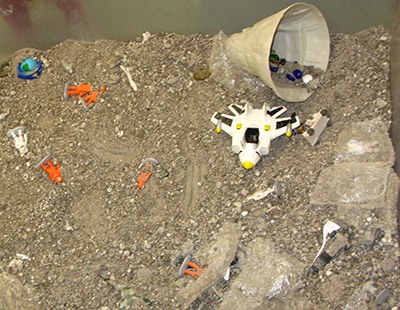Young children seem to always be on the move. Getting them to sit for any length of time is challenging. Even very young babies reach out to explore things around them. It is through this initial interaction with their world that children develop a sense of curiosity that leads to learning. Children learn best when they are engaged in exploring the world around them.

Early care providers can encourage this curiosity and make the most of this need to move and explore as they plan active learning experiences by considering the following:
- Each child has different abilities and interests. Spending time observing the child helps a provider to provide experiences that stimulate and interest each child.
- There should be many varied materials to choose from in the classroom. Materials that can be used in many different ways can be chosen.
- Children like to use their whole body. All of the senses can be considered when planning activities and collecting materials.
- Classroom materials should be accessible to the children. They need the freedom to make choices independently during uninterrupted free choice play periods.
- There should not be one "right" way to use a material or to do an activity. Children should be allowed to be messy and to interact with materials and learn from those interactions.
- More complex materials should be added as children grow and gain skills.
- Providers should be actively engaged in activities by communicating with children and by scaffolding their learning. This happens when children are acknowledged and encouraged to explore and learn. Providers should not be doing activities for children.
Take a holistic approach
Child growth and development occurs in several domains--physical, social/emotional, language, and cognitive. When planning curriculum it is important to take a holisitic approach, meaning materials and activities should support growth and development in all of these domains.
Sink & float
Materials:
- Container of water--bowl, bucket, water table.
- Variety of objects from the environment.
Description: Child is encouraged to place each object in the water to discover if it sinks or if it floats. The child can create a pile of objects that sink and a pile of objects that float. The activity can be extended by recording the results through photos, drawings or written log.
Color mixing
Materials:
- Red, yellow, blue food coloring
- 3 plastic cups of water
- 3 plastic droppers
- Styrofoam egg carton
Description: Put one drop of food coloring in each cup of water and put one dropper in each cup. Encourage child to put drops of food coloring in compartments of egg carton, mixing the three primary colors to create new colors. Extend activity by recording colors created using crayons and paper.
Let's create
Materials:
Variety of art materials accessible to child.
Description: Provide child with access to materials, allowing him to choose those he would like to use. Do not provide pre-made project or picture that he needs to recreate. Allow the child to use the materials as he chooses. For example, if he chooses to paint with his fingers instead of his brush, do not correct him. The goal is for him to explore the materials and use them to create what he would like to create.
Hardware basket
Materials:
- Assortment of hardware such as different sizes of nuts, bolts, carabiners, padlocks, washers, small sections of pipe, hinges, etc.
- Basket or box to hold hardware items
Description: Encourage children to explore the materials. Extend the activity by providing paper and writing implements to draw what they created. Share names of items and actions the child is doing with the objects such as twisting, screwing, stacking, building, etc.
Buried treasure
Materials:
- Sand table with sand and a variety of small objects buried in the sand. Include many magnetic objects such as paperclips, washers, etc.
- Magnet or magnetic wand
Description: Give the child the magnetic wand as a tool to find "buried treasure." Allow the child to explore and discover which items the magnet will pick up and which it will not.
Additional resources
- Cryer, D., T. Harms, and B. Bourland. 1995. Active Learning for Fours. Addison-Wesley Active Learning Series.
- Hohmann, M. and D. P. Weikart. 2002. Educating Young Children: Active Learning Practices for Preschool & Child Care Programs. High/Scope Educational Research Foundation: High/Scope Press.
Choking Cautions
Young children can choke on small objects and toy parts. All items used for children under three years of age and any children who put toys in their mouths should be at least 1¼ inch in diameter and between 1 inch and 2¼ inches in length. Oval balls and toys should be at least 1¾ inch in diameter. Toys should meet federal small parts standards. Any toys or games labeled as unsuitable for children under three should not be used.
Other items that pose a safety risk and should not be accessible to children under three include, but are not limited to: button batteries, magnets, plastic bags, styrofoam objects, coins, balloons, latex gloves, and glitter.
Activities 16-1

